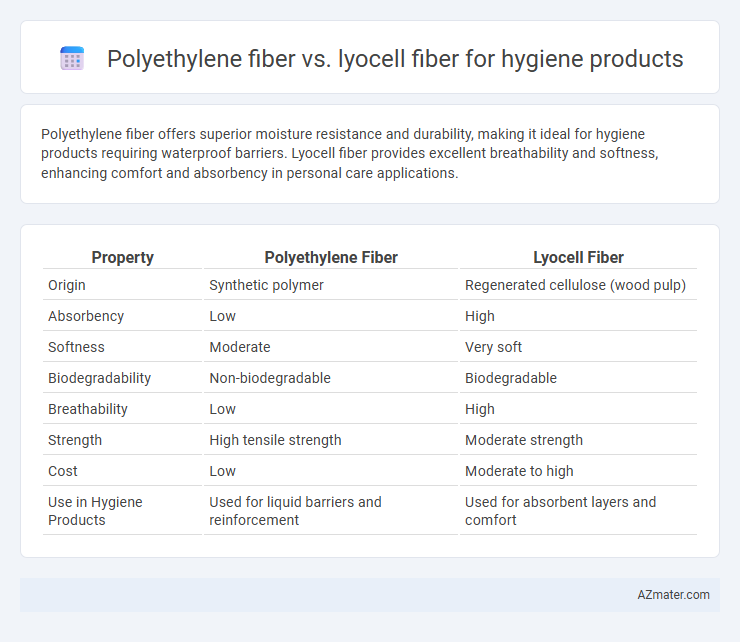Polyethylene fiber offers superior moisture resistance and durability, making it ideal for hygiene products requiring waterproof barriers. Lyocell fiber provides excellent breathability and softness, enhancing comfort and absorbency in personal care applications.
Table of Comparison
| Property | Polyethylene Fiber | Lyocell Fiber |
|---|---|---|
| Origin | Synthetic polymer | Regenerated cellulose (wood pulp) |
| Absorbency | Low | High |
| Softness | Moderate | Very soft |
| Biodegradability | Non-biodegradable | Biodegradable |
| Breathability | Low | High |
| Strength | High tensile strength | Moderate strength |
| Cost | Low | Moderate to high |
| Use in Hygiene Products | Used for liquid barriers and reinforcement | Used for absorbent layers and comfort |
Introduction to Polyethylene and Lyocell Fibers
Polyethylene fiber, derived from polymerized ethylene, is known for its exceptional strength, lightweight nature, and moisture resistance, making it ideal for hygiene products requiring durability and fluid repellency. Lyocell fiber, produced from sustainably sourced wood pulp through a solvent-spinning process, offers superior breathability, softness, and biodegradability, enhancing comfort and eco-friendliness in hygiene applications. Both fibers serve distinct roles in hygiene products, with polyethylene excelling in protective barriers and Lyocell providing skin-friendly, absorbent qualities.
Composition and Manufacturing Processes
Polyethylene fiber, composed of long chains of ethylene monomers, is produced through polymerization followed by melt spinning, resulting in strong, lightweight fibers ideal for moisture-wicking hygiene products. Lyocell fiber originates from cellulose cellulose derived from wood pulp, manufactured via a closed-loop solvent spinning process that significantly reduces environmental impact and produces soft, biodegradable fibers suitable for sensitive skin. The distinct chemical compositions and manufacturing techniques of polyethylene and lyocell fibers influence their performance, sustainability, and comfort in hygiene applications.
Environmental Impact and Sustainability
Polyethylene fiber, derived from non-renewable petroleum resources, has limited biodegradability and poses challenges in waste management, contributing to environmental pollution in hygiene products. Lyocell fiber, produced from sustainably sourced wood pulp through a closed-loop process, offers superior biodegradability and reduced chemical impact, making it a more eco-friendly option for hygiene applications. The sustainable sourcing and efficient manufacturing of lyocell significantly lower carbon footprint and water consumption compared to conventional polyethylene fibers.
Absorbency and Moisture Management
Polyethylene fiber exhibits low absorbency and poor moisture management, making it less suitable for hygiene products that require effective fluid control. Lyocell fiber, derived from cellulose, provides superior absorbency and excellent moisture-wicking properties, enhancing comfort and dryness in hygiene applications. Its natural breathability and biodegradability also make Lyocell a sustainable choice for managing moisture in hygiene products.
Softness and Skin Compatibility
Polyethylene fiber offers high durability but lacks the softness and breathability essential for hygiene products, often causing irritation on sensitive skin. Lyocell fiber, derived from sustainable wood pulp, provides superior softness, moisture-wicking properties, and excellent skin compatibility, making it ideal for sensitive and hygiene-focused applications. Its natural biocompatibility reduces the risk of allergic reactions and enhances user comfort in hygiene products like wipes and sanitary items.
Strength and Durability in Hygiene Applications
Polyethylene fiber exhibits high tensile strength and excellent resistance to moisture, making it ideal for hygiene products requiring durability under wet conditions. Lyocell fiber offers moderate strength combined with superior biodegradability and comfort, suitable for applications where sustainability and skin sensitivity are priorities. For long-lasting hygiene products subject to mechanical stress and repeated use, polyethylene fiber outperforms lyocell in maintaining structural integrity over time.
Biodegradability and Disposal
Polyethylene fiber, a synthetic polymer derived from petrochemicals, is not biodegradable and poses significant environmental challenges in hygiene product disposal due to its persistence in landfills and potential microplastic pollution. Lyocell fiber, made from sustainably sourced wood pulp through a closed-loop process, offers excellent biodegradability, breaking down naturally in composting environments and reducing waste impact. Choosing Lyocell fiber for hygiene products supports eco-friendly disposal methods and aligns with increasing demands for sustainable, biodegradable materials in the personal care industry.
Cost Comparison for Manufacturers
Polyethylene fiber offers a cost-effective solution for hygiene product manufacturers due to its lower raw material and production expenses compared to Lyocell fiber. Lyocell fiber, derived from wood pulp, has higher manufacturing costs associated with solvent spinning technology and sustainable sourcing, impacting overall pricing. Choosing polyethylene fiber can significantly reduce material costs while maintaining adequate performance for disposable hygiene applications.
Regulatory Compliance and Safety
Polyethylene fiber in hygiene products offers excellent chemical resistance and low moisture absorption, ensuring compliance with stringent FDA and EU regulations for direct skin contact. Lyocell fiber, derived from sustainably sourced cellulose, meets OEKO-TEX and GOTS certifications, emphasizing biodegradability and reduced environmental impact without compromising user safety. Both fibers undergo rigorous testing to meet ASTM and ISO standards for irritation, toxicity, and microbial resistance, making them suitable for sensitive hygiene applications.
Market Trends and Consumer Preferences
Polyethylene fiber commands significant market share in hygiene products due to its hydrophobic properties, durability, and cost-effectiveness, driving preference in disposable items like diapers and sanitary napkins. Lyocell fiber is gaining traction for its biodegradability, moisture-wicking ability, and skin-friendly nature, aligning with rising consumer demand for sustainable and eco-friendly hygiene solutions. Market trends indicate a shift towards blended fibers that combine polyethylene's robustness with lyocell's comfort and environmental benefits, catering to evolving consumer preferences for performance and sustainability.

Infographic: Polyethylene fiber vs Lyocell fiber for Hygiene product
 azmater.com
azmater.com